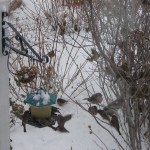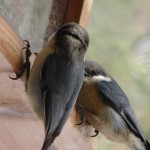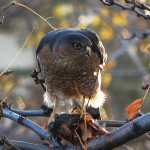Feeding and watching birds have become favorite pastimes in North America. It is estimated that 1/3 of the population feeds wild birds. This ranges from putting out scraps of food to serving seed, suet and nuts. During the winter time, especially in periods where the natural food source falls, feeders may be crucial.
Even though each year a huge amount of birdseed (in excess of 1 billion pounds) is consumed very little is known about the impact that this has. Recent studies suggest that birds only consume a fraction of their daily needs at feeders. At best what is consumed at feeders provides a supplement to the daily nutritional needs. 
To attract a wide variety of birds you will have to consider different offerings. A primary staple is the Black Oil Sunflower seed. Most birds are not seed eaters and rely on insects. During the winter their diet changes and they look to seed, berries and fruit. Sunflower seeds will attract cardinals, woodpeckers, blue jays, goldfinches, house finches, juncos, chickadees and house sparrows. My suggestion is to stick to Black Oil versus the grey and white striped sunflower seeds which people like to eat.
A second consideration might be Suet; which is solid fat rendered from beef and venison. This can be purchased in the form of a cake and then hung in a wire cage. Woodpeckers, starlings, chickadees, nuthatches and other species love suet.
If you want to attract goldfinches then Nyger is the seed of choice. Nyger is a black seed which is tiny and light and should be dispensed from a Tube seed feeder.
Peanuts are a good attractant for jays, nuthatches and starlings and should be placed in a special peanut feeder.
Many stores sell bags of mixed birdseed, I would stay away from these as most birds won’t eat it. Instead they will seek out, the black oil sunflower seed and kick out all of the other “filler” onto the ground.
There are several considerations that one needs to think about once you embark on this.
Predatory cats can be a problem; you may consider the placement of your feeder(s) so that cats cannot easily pounce on the birds. Attracting birds to feeders can also attract birds of prey such as Sharp Shined and Cooper’s Hawks which rely on smaller birds as their source of food. Make sure that your feeders are cleaned regularly as parasites may build up and make birds ill (cleaning involves scrubbing your feeder with a weak solution of bleach and water).
Finally, if you are interested in collecting data for scientific purposes you may want to consider Project Feederwatch . Project FeederWatch is a winter-long survey of birds that visit feeders at backyards, nature centers, community areas, and other locales in North America. FeederWatchers periodically count the highest numbers of each species they see at their feeders from November through early April. FeederWatch helps scientists track broad scale movements of winter bird populations and long-term trends in bird distribution and abundance.






Hi Romeo
I couldn’t agree more about the mixed bird seed; from my experience most of it goes uneaten by the very birds we are trying to help and might even attract unwanted rats. The only thing that I put out these days is Black Oil Sunflower seed.
When I first moved to the Okanagan from the lower mainland in BC I tried suet cakes. Much to my surprise it went untouched. In Port Coquitlam where I lived for many years I was going thru a suet cake every 2 days. As these are not cheap when purchased individually I used to buy them in bulk. At one time I made my own suet; but found that to be very time consuming.
It is difficult to know what percentage of a bird’s diet comes from the food that we put out, some say it is less than 10%. Whatever the cost and effort it gives many people great joy to observe birds at a feeder.
Greg
Another important thing to note is how much of the seed you are giving is actually just filler. Many less expensive feeds use a lot of filler, which the birds don’t generally eat and are basically a waste of money and can make a mess in your yard. Filler seeds include milo, sorghum, red millet and golden millet. Birds will push through these fillers to get the food they want, so it is more financially sound to choose one that is higher quality.: